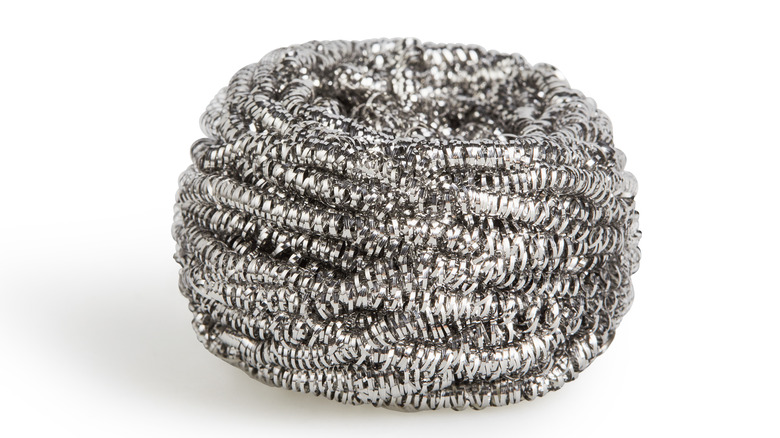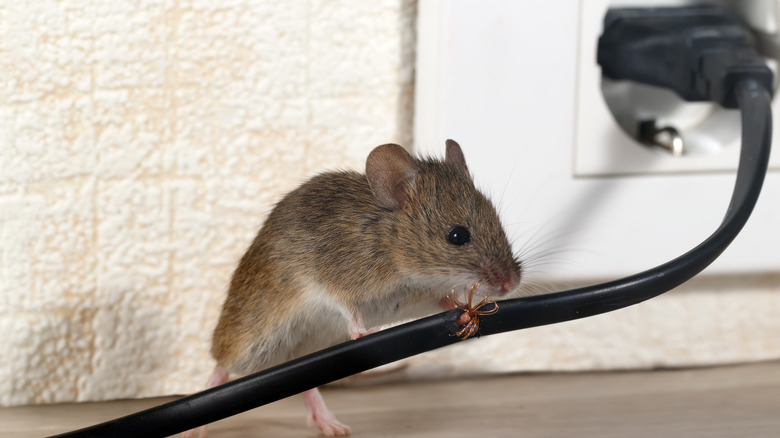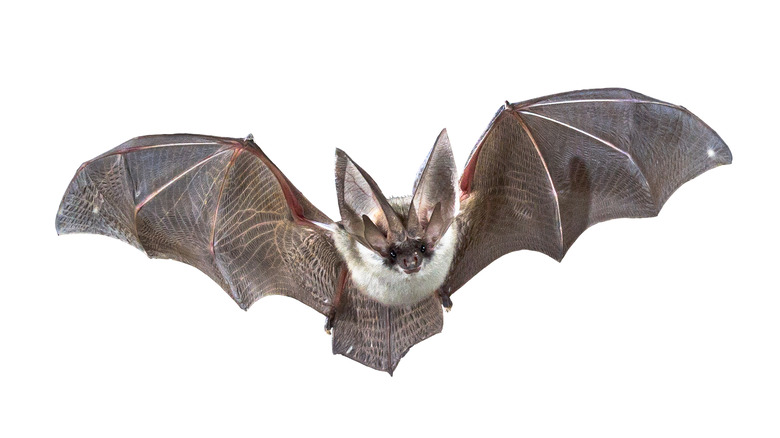The Most Important Place To Use Steel Wool That You're Probably Missing
A mouse can climb walls, squeeze through a hole the width of a pencil, and give birth to a dozen offspring every three weeks. A rat can survive a 50-foot fall. But one thing those rodents cannot do is penetrate a barrier of steel wool to wreak havoc in your kitchen, cabinets, and drawers. Conventionally used to clean encrusted pots and pans and valuable as an all-purpose abrasive, steel wool is also a mouse and rat deterrent of the first order. Steel wool is fine metal wire clustered together into a sheet or pad. It was invented in 1896 and took its name from its resemblance to sheep's wool, according to Skedaddle Humane Wildlife Control. Similar mesh forms are made from copper, bronze, and aluminum. Per Encyclopedia, its forerunners were Victorian-era pot scrubbers affixed with steel and metal shavings used for polishing other metals.
Steel wool is well-suited for keeping pests out, primarily when used with silicone caulking. Sealing holes, gaps, and other points of entry will effectively deter rodents without resorting to poison. The wool can be wedged under a door as a mouse-repelling alternative to weather stripping. Rodents can't chew through the metal, and its sharp edges will discourage the vermin by poking them in the nose or hurting their teeth if they try. So the next time you are looking for a pan cleaner, keep an extra batch of steel wool on hand to keep Mickey Mouse at bay.
Prevents rodents from getting inside
According to the National Pest Management Association, rodents gain entry into 21 million American homes each year, most often during late fall and early winter. Once inside, a major infestation is an inevitable result. Denying entry is the most effective approach; short of professional intervention, a steel wool defense works best. As described by Cooper Pest Solutions, wall holes or cracks, areas near baseboards and the edges of crawl spaces, and the vicinity of utility pipes, cables, and wires, are vulnerable and can be shored up using steel wool. Keep in mind an adult mouse can wriggle through a dime-sized opening. Mice lack collarbones, and two-thirds of their diameter is hair, so even the slightest gap should be sealed to keep the tiny creature out and tightly so.
Integrity Pest Management recommends packing the defect with steel wool and completely caulking around it to secure the metal seal. The putty smooths out the wool patch and prevents a tenacious mouse from pulling or kicking the steel wool out. This fix will prove to be unchewable, impenetrable, and unmovable, and mercifully, the would-be invader will not be able to ingest any of the steel wool. Eating the metal could prove fatal. Stainless steel wool of medium coarseness and silicone caulking is considered the best materials for this purpose.
Other steel wool attributes
Steel wool is easy to use, readily available, and inexpensive. It is non-toxic, so totally okay to use without threatening children or pets. No particular safety measures are needed other than protective gloves. Steel wool is very pliable, making it effective for shaping it to fit rodent entry points of any size or shape. The metal bundle can safely be used around heating pipes and won't impede ventilation. Removing a steel wool patch will be possible as well, per Ekksol. There are a few drawbacks to using steel wool, however. Moisture might cause corrosion and deterioration.
In some cases, it is perhaps more appropriate as a temporary defense. Steel wool is also a preventative, not a solution, to a rodent invasion. The plugs may also be counterproductive if one has already gotten in — It will keep the pest inside. While on the subject of rodents, steel wool can help bar invasive bats from your home. According to StarTribune, determine where they are exiting at twilight and count the number of animals. During the day, use steel wool to plug all but one hole. Allow a few days to get accustomed to using that exit, then seal as soon as the last one has departed. If there is only a single hole, stuff it as soon as all the bats have left. Now, if only you could figure out how to keep that squirrel out of the attic!


